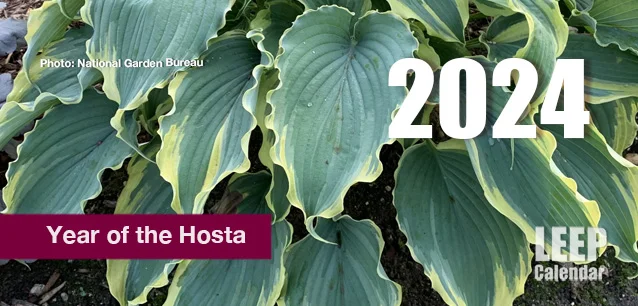 AD
AD
Today is: November 21
Scroll to explore events active on this date.
Additional Events on LEEP
LEEP INK FEATURES

August is Appropos
A toddler playing in the fountain at a park in Santa Fe, New Mexico—Photo LD Lewis. In August, we live through the Dog Days of Summer. It's hot and often humid, and those ...

September is Sassy
Can you hear that sigh of relief from parents worldwide? Yes! September marks the return of students to school, a global phenomenon. Preparations for the ACT and SATs begin earnestly for ...

OOH LA LA, October
October is the busiest month for events, with 5% more happening than in May, the second most eventful month. Sailing enthusiasts will be glued to the finals of this year's Am...
About 2024, the Year of the Hosta
Retail
Ends: Dec 31, 2024
DESCRIPTION:
2024 is the Year of the Hostas.
Hostas, known for their lush foliage and shade-loving nature, are a popular perennial plant in many gardens. Originally from northeast Asia, particularly Japan, China, and Korea, hostas have become a staple in temperate gardens worldwide. Their ability to thrive in shaded areas, where many other plants struggle, has contributed significantly to their popularity.
There are approximately 70 species of hostas, but the world of hostas extends far beyond these thanks to extensive hybridization efforts. These efforts have resulted in thousands of registered cultivars, each with unique characteristics. Hostas come in various leaf shapes, textures, and colors, including green, blue, and yellow variations, and even variegated patterns that combine multiple colors.
Hostas are primarily grown for their foliage, ranging in size from tiny leaves a few inches long to giant varieties with leaves over a foot wide. The plant's foliage can be as small as a few inches or centimeters in height and width to over a yard or meter in size. In addition to their stunning leaves, many hostas produce delicate flowers on tall stalks in the summer, ranging in color from white to lavender and purple.
One of the reasons for the hosta's popularity is its ease of care. These plants are hardy and can tolerate various soil conditions, although they prefer moist, well-drained soils. They are ideal for shady gardens, thriving under trees or on the north side of buildings where other plants might not grow as well. Despite their hardiness, hostas can be susceptible to pests like slugs and deer, which are attracted to their tender leaves.
Hostas add versatility to landscaping as border plants, groundcover, and alone. Their versatility, low maintenance, and beautiful foliage ensure that hostas remain a beloved choice for gardeners worldwide.
VIDEOS
SUPPORTING DOCUMENTS
Currently, this event does not have supporting documents.
ADDITIONAL IMAGES
Currently, this event does not have supporting images.
Where would you like to go now?
 AD
AD


/footer-logo.svg)
